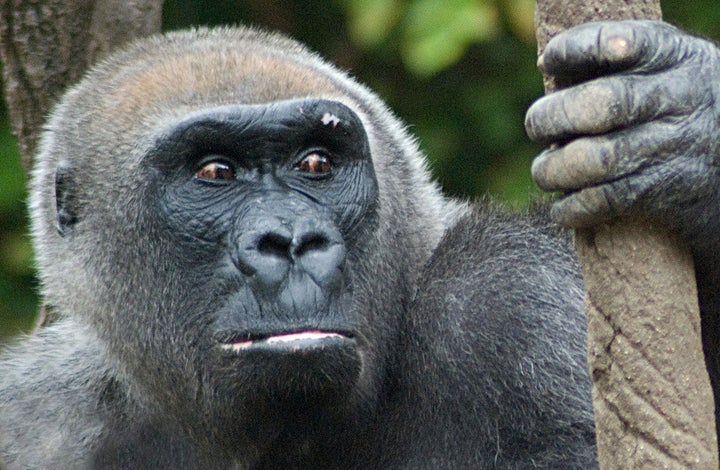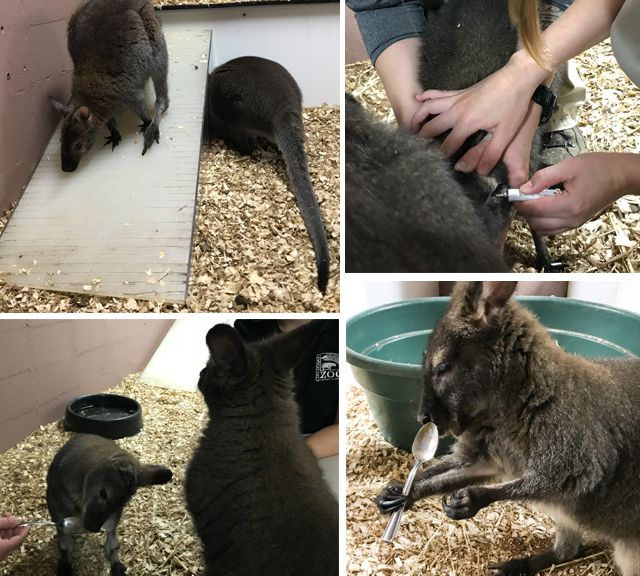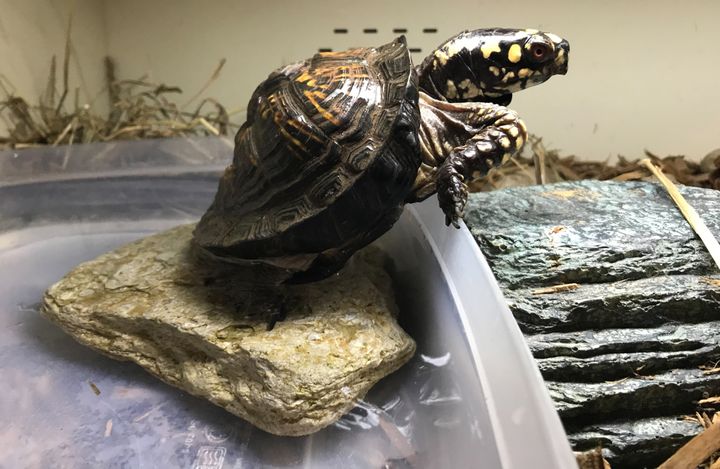Many of the older animals at the Cincinnati Zoo require the same TLC and medications as your grandparents might. Arthritis, high blood pressure, vision and cardiac issues are as common in animals as they are in humans. As a result, the Zoo’s hospital is stocked with anti-inflammatories, diuretics and beta blockers.
Animals in Zoos tend to live longer than they would in the wild, where there is no such thing as senior care. They are safe from predators, get plenty to eat and receive medical treatment for common ailments such as a bad tooth or arthritis.
Preventative care is also responsible for the longevity of Zoo seniors. Thanks to the training expertise of the animal care team, the Zoo’s veterinarians are able to perform many medical procedures without using anesthesia. They’ve employed operant learning techniques (positive reinforcement for desired behaviors) to teach gorillas to stand in place for cardiac exams, rhinos to put up with blood draws and polar bears to tolerate ultrasounds.
Cincinnati Zoo’s animal care staff does everything possible to make our animals comfortable in their golden years, including providing special diets, habitat modifications and specialized medical attention.
Meet some of Cincinnati Zoo’s older animals:
Western Lowland Gorilla “Samantha”Age 47 – Median life expectancy – 31 years

Samantha, daughter of the legendary founder gorillas King Tut and Penelope, is the oldest mammal at the Cincinnati Zoo. She was one of the first gorilla babies born and raised at the Cincinnati Zoo and has given birth to six babies over the years.
Last month, an oral surgeon visited to remove a tooth that was causing Samantha problems. During the surgery, vets performed a complete physical and found her to be in pretty good shape for her age, but they’re keeping an eye on her ticker. She has been trained to allow awake cardiac exams, which greatly facilitates regular heart exams. Special, proactive modifications, such as switchbacks to minimize vertical climbing, were built into the newly-renovated Gorilla World to accommodate aging animals.
Polar Bear “Little One”Age 28 - median life expectancy – 20 years

Little One is well past his prime and the care team has done a lot to make sure he’s healthy and comfortable, including husbandry modifications such as unlimited access to dens, thick straw beds inside and out, and new forms of enrichment that encourage movement. The Zoo brought in live fish last week to provide Little One and his girlfriend, Anana, with the opportunity to catch their food before eating it. The activity stimulated the bears mentally and physically, and they seemed to enjoy it! A new ice machine has been ordered to help keep pool temperatures low and to allow the bears to play in big piles of ice throughout the year.
Clouded leopard Tevi Age 15 - median life expectancy – 12-15

Fifteen-year-old clouded leopard Tevi has been trained, using positive reinforcement, to walk into a specially designed box that allows the keepers to feed her while the vet techs give her subcutaneous fluids to help with her renal function. Voluntarily participating in procedures like this reduces the need for sedation, minimizing health risks and stress. She gets a higher fat diet to help her keep her figure. As for TLC, she gets all sorts of enrichment and fun treats to keep her active and healthy!
White Tigers “Popsy” & “Akere” Age 21 – median life expectancy – 20 years

The white tigers’ habitat has been modified with multiple levels and ramps to help them navigate hills, and their water area was reconfigured to allow easier access. They only go outside when the temperature is above 60 F and it’s sunny.
Akere received a complete physical last week to determine why he has been losing weight and, unfortunately, vets found a cancerous lesion in his mouth. Surgery is not an option due to his age and the severity and location of the lesion. He’s being offered small amounts of his favorite foods throughout the day.
California Sea Lion “Duke”Age 29 - Median life expectancy – 23 years

Duke has had vision problems, which are common in sea lions, for decades. He is now completely blind but knows his way around his environment very well. In the winter months, he usually chooses to stay in his pool instead of coming out on land because the pool temp is warmer than the air temp and with a thick blubber layer he is very well insulated. He has a small heated area and a thick rubber mat to lay on in his indoor habitat which is always open for him if he chooses to go there.
Jazz the Wallaby (approximately 16 years old)

L to R clockwise: Rocko checks out the new ramp; Care team applies eye ointment; Jazz gets meds hidden in peanut butter while Rocko waits for his spoonful; Rocko can do it all by himself!
Jazz has limited sight and hearing. Interestingly, one of the other wallabies, Rocko, often serves as her eyes and ears. He stays close to her and uses his body to guide her in the right direction. Because of that, he’s often in the way when keepers are trying to give Jazz treats or medication. They know to bring enough for him. The wallaby space has been specially outfitted with a ramp so Jazz can reach higher areas and her diet includes pre-softened and higher calorie foods. She has an eye issue that keepers treat with ointment 2 times daily.
Other Seniors

Eastern box turtle Juliet climbs out of her soaking pool
Other older animals include a 34-year-old king penguin, Burger, that is partially blind and is fed by hand, a six-year-old skunk that gets milk thistle to help with her liver issues and has been retired from breeding, two box turtles, ages 68 and 27, that have ramps and their own private spaces, a 23-year-old armadillo that gets special substrate to help her with traction, and a 20-year-old tawny frogmouth named Kermit that gets bandages changed on his injured leg twice a week. Screech owl Van Gogh, age 12, gained weight after retiring from programs and has started a special exercise program.
The Animal Care Team
Three veterinarians, two veterinary technicians and a nutritionist work together in close association with animal keeper staff to make sure that the 2,000 animals - reptiles, birds, insects, mammals and amphibians - at the Zoo get the best possible care, whether they’re young or old.
Besides vets on staff, the Zoo reaches out to specialists in every discipline, medical and veterinary, to accommodate the needs of the aging population, including dental, vision, surgical and cardiac care.

“It depends on the species and what they need and how we can best care for them in their golden years,” said Dr. Mark Campbell, Cincinnati Zoo’s director of animal health. “It’s all about making them more comfortable, keeping a closer eye on them and giving them a lot of TLC.”
About the Cincinnati Zoo:
The world famous Cincinnati Zoo & Botanical Garden is committed to inspiring visitors to care about wildlife and wild places. It has been rated the #1 attraction locally and one of the top zoos in the nation by Zagat Survey. It has also received rave reviews from Child Magazine, Parents Magazine, USA Today and TripAdvisor. Over 1.5 million people visit the Zoo’s award-winning exhibits, and more than 500 animal and 3000 plant species annually. The Zoo, an accredited member of the Association of Zoos & Aquariums (AZA), is internationally known for its success in the protection and propagation of endangered animals and plants and engages in research and conservation projects worldwide. Known as the #GreenestZooInAmerica, the Zoo is doing its part to conserve natural resources that are critical to saving wildlife and its habitats and is committed to greening its daily operations and reducing its impact on the environment through the use of rain gardens, recycled building materials, solar panels and more. The Cincinnati Zoo is a 501(c)(3) nonprofit organization.
